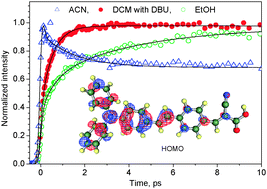Interrogating the ultrafast dynamics of an efficient dye for sunlight conversion†
Abstract
We report on studies of the recently synthesized compound (TPC1) with a promising potential use in

* Corresponding authors
a
Departamento de Química Física, Sección de Químicas, Facultad de Ciencias del Medio Ambiente, Universidad de Castilla-La Mancha, Avda. Carlos III, S.N., 45071 Toledo, Spain
E-mail:
Abderrazzak.douhal@uclm.es
Fax: +34 926 268840
Tel: +34 925 265717
b State Key Laboratory of Fine Chemicals, Dalian University of Technology (DUT), 158 Zhongshan Road, 116012 Dalian, China
c School of Chemical Science and Engineering, Department of Chemistry, Royal Institute of Technology (KTH), Teknikringen 30, 10044 Stockholm, Sweden
We report on studies of the recently synthesized compound (TPC1) with a promising potential use in

 Please wait while we load your content...
Something went wrong. Try again?
Please wait while we load your content...
Something went wrong. Try again?
M. Ziółek, X. Yang, L. Sun and A. Douhal, Phys. Chem. Chem. Phys., 2010, 12, 8099 DOI: 10.1039/C002338H
To request permission to reproduce material from this article, please go to the Copyright Clearance Center request page.
If you are an author contributing to an RSC publication, you do not need to request permission provided correct acknowledgement is given.
If you are the author of this article, you do not need to request permission to reproduce figures and diagrams provided correct acknowledgement is given. If you want to reproduce the whole article in a third-party publication (excluding your thesis/dissertation for which permission is not required) please go to the Copyright Clearance Center request page.
Read more about how to correctly acknowledge RSC content.
 Fetching data from CrossRef.
Fetching data from CrossRef.
This may take some time to load.
Loading related content
